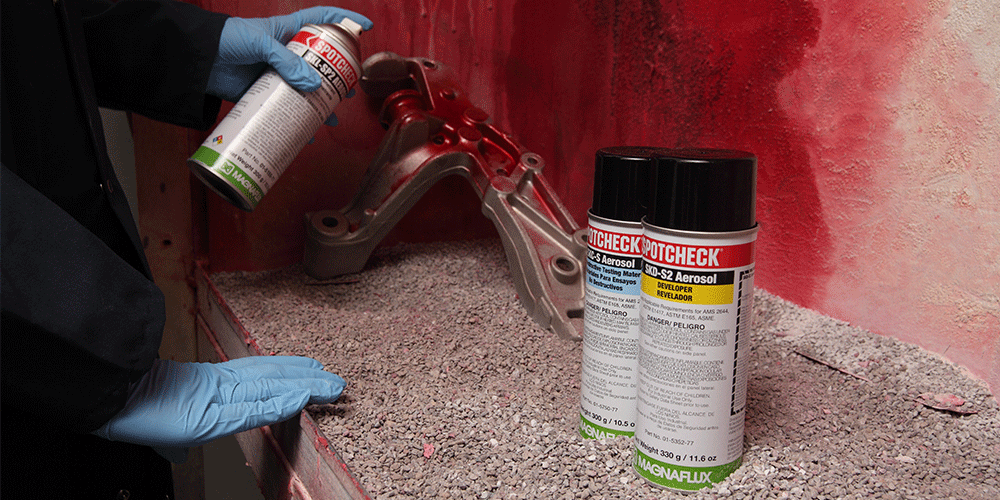
How to Inspect Aluminum Cylinder Heads for Cracks Using Magnaflux Spotcheck Products
Share
Detecting cracks in aluminum cylinder heads is crucial for engine reliability and performance. Unlike ferrous metals that can be inspected with magnetic particle testing, aluminum requires a different approach. Magnaflux Spotcheck dye penetrant inspection is the industry standard for finding surface-breaking defects in aluminum components. This non-destructive testing method reveals even hairline cracks that could lead to catastrophic engine failure.
Understanding Dye Penetrant Inspection
Dye penetrant testing works by using a brightly colored liquid that seeps into surface-breaking discontinuities. After allowing dwell time for penetration, excess dye is removed and a developer is applied, drawing the penetrant back out of cracks to create highly visible indications. This method is ideal for aluminum cylinder heads because it doesn't require the component to be magnetic.
Required Materials
To perform a proper inspection, you'll need the complete Magnaflux Spotcheck SK-816 Kit from NDT Supplies, which includes:
- SKC-S Cleaner/Remover - For pre-cleaning and removing excess penetrant
- SKL-SP2 Solvent Removable Penetrant - Red dye penetrant for excellent visibility
- SKD-S2 Developer - Creates a white background for high contrast
You'll also need clean, lint-free rags and adequate lighting for the inspection area.
Step-by-Step Inspection Process
Step 1: Initial Cleaning
Before applying any testing materials, the cylinder head must be thoroughly cleaned. Remove all oil, grease, carbon deposits, and contaminants that could prevent the penetrant from entering cracks.
- Spray the SKC-S Cleaner/Remover directly onto the aluminum surface
- Wipe down with a clean rag to remove all contaminants
- Pay special attention to valve seat areas, combustion chambers, and between ports
- Allow the surface to dry completely before proceeding
Step 2: Apply the Penetrant
With the surface clean and dry, you're ready to apply the red dye penetrant.
- Shake the SKL-SP2 Penetrant can thoroughly
- Hold the aerosol 6-12 inches from the surface
- Apply a uniform, wet coating over all areas to be inspected
- Ensure complete coverage of suspect areas, including valve guides, water jacket walls, and between ports
- Allow dwell time of 10-30 minutes (longer dwell times improve sensitivity for tight cracks)
The penetrant needs time to seep into any surface-breaking defects. During this dwell time, capillary action draws the red dye into even the smallest cracks.
Step 3: Remove Excess Penetrant
After the dwell time, excess penetrant must be carefully removed without pulling dye out of actual defects.
- Spray SKC-S Cleaner/Remover onto a clean rag (never spray directly on the part)
- Gently wipe the surface to remove excess red penetrant
- Use minimal pressure and fresh portions of the rag
- Continue until the surface appears clean with no visible red dye
- Do not over-wipe, as this can remove penetrant from cracks
Step 4: Apply Developer
The developer creates a white background and draws penetrant out of cracks for easy visualization.
- Shake the SKD-S2 Developer can well
- Hold 10-12 inches from the surface
- Apply a thin, uniform white coating over the entire inspection area
- The developer should create an opaque white layer
- Wait 10-15 minutes for indications to develop
As the developer dries, any penetrant trapped in cracks will be drawn to the surface, creating bright red lines or spots against the white background.
Step 5: Inspect for Cracks
Now comes the critical evaluation phase. Look carefully at all areas of the cylinder head under good lighting.
Common crack locations in aluminum cylinder heads:
- Between valve seats (especially between exhaust valves)
- Around valve guide bosses
- In combustion chamber corners
- Between coolant passages and valve seats
- At bolt hole edges
- Around spark plug holes
Cracks will appear as bright red indications against the white developer background. Even hairline cracks that are invisible to the naked eye will show up clearly. Use a magnifying glass for detailed examination of suspect areas.
Step 6: Documentation and Interpretation
Document all findings with photographs. Linear red indications typically represent cracks, while rounded indications may be porosity. The size, location, and orientation of indications help determine if the head is serviceable or requires repair or replacement.
Important Considerations
Temperature Matters: Perform inspections at temperatures between 50°F and 125°F for best results. Extreme temperatures can affect penetrant performance.
Ventilation: Always work in a well-ventilated area. While Spotcheck products are designed to be safe, proper airflow is important when using aerosol products.
Surface Preparation is Critical: The most common cause of missing defects is inadequate cleaning. Take the time to properly clean the surface before starting the inspection process.
Limitations: Dye penetrant testing only detects surface-breaking defects. Subsurface cracks or internal porosity won't be detected. For comprehensive evaluation, pressure testing should be performed in conjunction with dye penetrant inspection.
Why Choose Magnaflux Spotcheck Products
Magnaflux Spotcheck products meet major military and industry specifications, including aerospace requirements. The complete SK-816 kit provides everything needed in convenient aerosol form, making it perfect for shop or field inspections. The solvent-based system is specifically formulated to work with aluminum, magnesium, titanium, and other special alloys commonly used in performance engines.
Conclusion
Inspecting aluminum cylinder heads with Magnaflux Spotcheck dye penetrant is a straightforward yet highly effective process when performed correctly. The vivid red-on-white contrast makes even the smallest cracks visible, giving you confidence in your engine components. Whether you're rebuilding a high-performance engine or performing routine maintenance inspections, investing in quality inspection products from NDT Supplies ensures you catch problems before they lead to expensive failures.
Regular inspection of cylinder heads, especially after overheating events or when rebuilding engines, can save thousands in potential damage. With the right technique and quality Magnaflux products, you can perform professional-grade inspections in your own shop.
